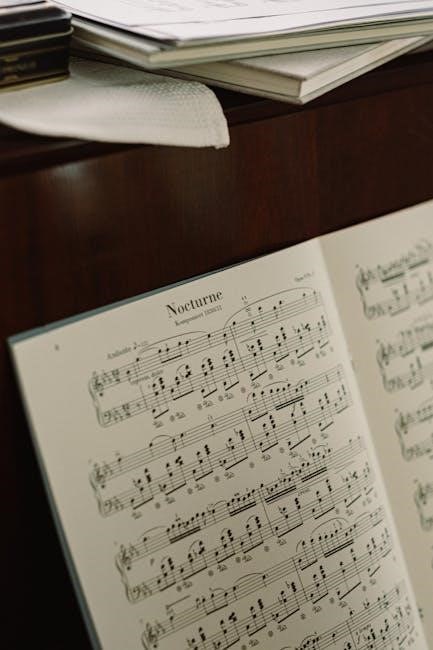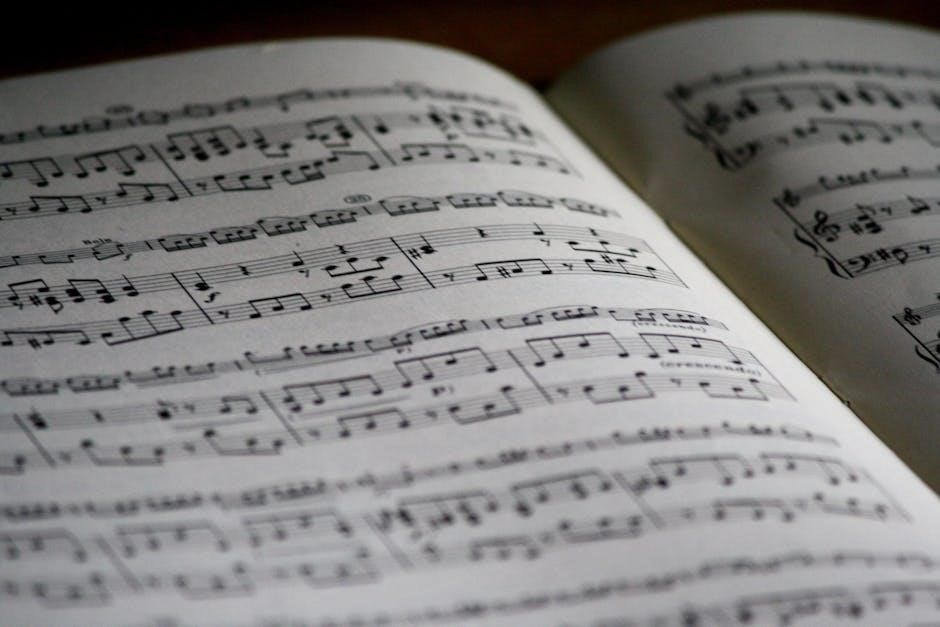
Music Theory Cheat Sheet PDF: An Overview
Music theory is the backbone of musical comprehension‚ and a cheat sheet PDF offers a succinct roadmap․ It helps musicians quickly reference essential concepts‚ improving understanding of composition and performance in their musical journey․
Basic Music Theory Concepts
Basic music theory involves fundamental elements․ These elements are the foundation for understanding musical structure․ These elements include notes‚ scales‚ rhythms‚ harmony‚ and form․ Mastering these concepts unlocks deeper appreciation and creation in music․
Musical Notes and Intervals
Understanding musical notes is fundamental․ Notes represent pitch and duration and are the building blocks of melodies and harmonies․ The standard musical alphabet consists of A‚ B‚ C‚ D‚ E‚ F‚ and G․ Each note corresponds to a specific frequency․ Notes can be altered using sharps (#) and flats (b)‚ raising or lowering the pitch by a half step․ Intervals describe the distance between two notes․
Intervals are classified by their size (e․g․‚ second‚ third‚ fifth) and quality (e․g․‚ major‚ minor‚ perfect)․ Recognizing intervals is crucial for understanding chord construction and melodic movement․ Common intervals include major and minor seconds‚ thirds‚ perfect fourths and fifths‚ and octaves․ Intervals can be consonant (stable and pleasing) or dissonant (unstable and creating tension)․ Mastering notes and intervals is essential for analyzing‚ composing‚ and performing music effectively‚ enhancing musical intuition and communication․
Key Signatures
Key signatures are a set of sharps or flats placed at the beginning of a staff to indicate the key of a piece of music․ They provide a visual shorthand‚ avoiding the need to write accidentals (sharps or flats) before individual notes․ Each key signature corresponds to a specific major and minor key․ The order of sharps in a key signature is F#‚ C#‚ G#‚ D#‚ A#‚ E#‚ and B#․
The order of flats is the reverse: Bb‚ Eb‚ Ab‚ Db‚ Gb‚ Cb‚ and Fb․ Determining the key from a key signature involves recognizing the pattern of sharps or flats․ For major keys‚ the last sharp is a half step below the tonic․ For flat keys‚ the second-to-last flat is the tonic․ Understanding key signatures helps musicians quickly identify the tonal center‚ aiding in sight-reading‚ analysis‚ and composition․
Scales and Modes
Scales are ordered sequences of notes that form the basis of melodies and harmonies in music․ The most common scale is the major scale‚ characterized by a bright‚ uplifting sound‚ while the minor scale has a darker quality․ Modes‚ also known as church modes or Greek modes‚ are variations of the major scale‚ each with a unique intervallic structure and character․
There are seven modes: Ionian‚ Dorian‚ Phrygian‚ Lydian‚ Mixolydian‚ Aeolian‚ and Locrian․ Understanding scales and modes is crucial for composing melodies‚ creating chord progressions‚ and analyzing music․ Each scale and mode has a distinct sound due to the different intervals between its notes․ By understanding the characteristics of each scale‚ musicians can enhance their creative expression and create music․
Chords
Chords are groups of three or more notes played simultaneously‚ forming the foundation of harmony in music․ The most basic chord is a triad‚ which consists of a root‚ a third‚ and a fifth․ Chords can be major‚ minor‚ diminished‚ or augmented‚ depending on the intervals between the notes․
Major chords have a bright‚ happy sound‚ while minor chords have a darker‚ sadder quality․ Understanding chords is essential for creating chord progressions‚ accompanying melodies‚ and analyzing music․ Different voicings and inversions of chords can create unique textures and harmonic effects․ By experimenting with various chord types and progressions‚ musicians can unlock a wide range of musical possibilities․

Fundamentals of Music Notation
Music notation is the written language of music․ Learning the symbols‚ staff‚ clefs‚ and note values is crucial․ A solid understanding of these fundamentals allows musicians to read‚ write‚ and interpret musical scores effectively․
The Staff‚ Clefs‚ and Ledger Lines
The foundation of musical notation lies in understanding the staff‚ clefs‚ and ledger lines․ The staff comprises five horizontal lines and four spaces‚ each representing a specific pitch․ Clefs‚ such as treble and bass‚ assign particular pitches to these lines and spaces‚ orienting musicians within a comfortable vocal or instrumental range․
The treble clef‚ often used for higher-pitched instruments and voices‚ centers around G above middle C‚ while the bass clef‚ for lower registers‚ focuses on F below middle C․ Ledger lines extend the staff above or below‚ accommodating notes outside the standard range․ These lines‚ short and parallel to the staff‚ allow for the notation of higher or lower pitches․
Mastering the staff‚ clefs‚ and ledger lines is fundamental to reading and writing music․ Recognition enables musicians to accurately interpret and perform written scores‚ bridging the gap between written symbols and musical sound‚ aiding both performance and composition․
Note Values and Rhythms
Understanding note values and rhythms is crucial for interpreting musical time․ Note values dictate the duration a note is held‚ with whole notes receiving four beats‚ half notes two‚ quarter notes one‚ and so on․ These values create a hierarchical system of durations‚ allowing for complex rhythmic patterns․ Rests‚ corresponding to each note value‚ indicate silence․
Rhythm involves the arrangement of sounds and silences in time․ It’s the pulse and groove that defines a piece․ Time signatures‚ like 4/4 or 3/4‚ specify the number of beats in a measure and the note value that receives one beat․ Dotted notes increase duration by half‚ while ties combine note values across bar lines․
Understanding note values and rhythms allows musicians to accurately perform written music‚ maintaining tempo and groove․ Grasping these concepts allows for a deeper comprehension of musical structure and rhythmic interplay‚ enabling informed artistic choices․
Time Signatures
Time signatures are essential for understanding the rhythmic framework of music․ They appear at the beginning of a piece and indicate the number of beats in each measure (the top number) and the type of note that receives one beat (the bottom number)․ For example‚ 4/4 time signifies four beats per measure‚ with the quarter note getting one beat․
Common time signatures include 3/4 (three beats per measure‚ quarter note equals one beat)‚ 2/4 (two beats per measure‚ quarter note equals one beat)‚ and 6/8 (six beats per measure‚ eighth note equals one beat)․ Compound time signatures‚ like 6/8‚ divide the beat into three subdivisions‚ creating a different rhythmic feel․
Understanding time signatures allows musicians to accurately interpret and perform rhythms․ Recognizing the meter and beat divisions enables proper phrasing and rhythmic accuracy‚ enhancing musical expression․ Variations within a piece can create rhythmic interest and complexity‚ enriching the musical texture․

Harmony and Melody
Harmony and melody form the core of music․ Melody is the linear sequence of notes‚ while harmony supports the melody with chords; Their interplay creates musical texture and expression‚ and evokes emotion․
Chord Progressions
Chord progressions are the backbone of harmonic structure in music․ They are sequences of chords that create a sense of movement and direction‚ guiding the listener through a musical piece․ Understanding chord progressions is crucial for composing‚ arranging‚ and analyzing music․ Common chord progressions‚ such as the I-IV-V-I‚ provide a foundation for countless songs across various genres․
A cheat sheet PDF can be an invaluable tool for musicians seeking to master chord progressions․ It offers a quick reference to frequently used progressions‚ their Roman numeral notation‚ and examples of how they sound․ By studying and internalizing these patterns‚ musicians can develop a deeper understanding of harmony․ This will enable them to create more compelling and emotionally resonant music․
Furthermore‚ a chord progression cheat sheet can help musicians quickly identify and analyze the harmonic structure of existing songs․ This skill is essential for transcribing‚ arranging‚ and improvising․ It allows musicians to understand the underlying harmonic framework and make informed decisions about their own musical contributions․
Melodic Structure and Development
Melodic structure and development are essential components of music composition․ They define how a melody is constructed and how it evolves over time․ A well-crafted melody should be memorable‚ engaging‚ and emotionally resonant․ Understanding melodic principles is crucial for creating compelling musical pieces․
Melodic structure involves elements like contour‚ range‚ and phrasing․ Contour refers to the shape of the melody‚ whether it rises‚ falls‚ or remains relatively stable․ Range describes the distance between the highest and lowest notes․ Phrasing involves grouping notes into meaningful segments‚ similar to sentences in language․ Melodic development involves techniques like repetition‚ variation‚ and contrast․ Repetition reinforces key melodic ideas‚ while variation introduces subtle changes․ Contrast provides moments of surprise and interest․
A cheat sheet PDF can be a valuable resource for understanding melodic structure and development․ It can provide examples of common melodic patterns‚ scales‚ and modes․ It can also offer tips on how to create effective melodies․ By studying and applying these principles‚ musicians can enhance their ability to craft captivating melodies․ This will elevate their overall musical compositions․

Advanced Music Theory Topics
Delving into advanced music theory unveils complex concepts․ This includes intricate harmonic structures‚ counterpoint techniques‚ and modulation strategies․ A cheat sheet PDF can serve as a condensed guide․ It helps navigate these sophisticated musical landscapes efficiently․
Modulation
Modulation‚ a cornerstone of advanced music theory‚ involves transitioning from one key to another within a composition․ This technique enriches the harmonic landscape‚ adding depth and emotional nuance․ Effective modulation requires a deep understanding of key relationships‚ pivot chords‚ and voice leading principles․ A cheat sheet PDF can provide a concise reference for common modulation techniques‚ such as direct modulation‚ pivot chord modulation‚ and sequential modulation․ Understanding these techniques allows composers and arrangers to seamlessly shift between tonal centers‚ creating dynamic and engaging musical narratives․
Furthermore‚ a cheat sheet can offer visual aids‚ showcasing common pivot chords and their corresponding key changes․ It can also outline the steps involved in planning and executing a successful modulation‚ from selecting appropriate pivot chords to ensuring smooth voice leading in the transition․ Mastering modulation opens up a vast array of creative possibilities‚ enabling musicians to craft more expressive and sophisticated compositions․ By providing a quick and accessible reference‚ a PDF cheat sheet empowers musicians to explore and implement modulation techniques with greater confidence and skill․
Counterpoint
Counterpoint‚ a sophisticated element within advanced music theory‚ focuses on the art of combining multiple independent melodic lines to create a harmonious texture․ Mastering counterpoint demands a thorough comprehension of melodic contour‚ rhythmic independence‚ and harmonic compatibility․ A cheat sheet PDF can serve as a valuable resource‚ offering concise guidelines on the five species of counterpoint: note-against-note‚ two notes against one‚ four notes against one‚ suspension‚ and florid counterpoint․ Understanding these species provides a structured approach to crafting intricate and engaging polyphonic textures․
Moreover‚ a counterpoint cheat sheet can outline essential rules regarding consonance‚ dissonance treatment‚ and voice leading․ It can also offer examples of how to apply counterpoint techniques in various musical styles‚ from classical fugues to contemporary compositions․ Visual aids‚ such as examples of well-crafted counterpoint passages‚ can further enhance understanding and application․ By providing a quick and accessible reference‚ a PDF cheat sheet empowers musicians to explore the intricacies of counterpoint‚ enriching their compositions with depth and complexity․ It helps ensure adherence to established principles while fostering creative expression․

Resources for Learning Music Theory
Numerous resources exist for learning music theory‚ including online courses‚ textbooks‚ and interactive software․ Free PDF books and worksheets are also invaluable for beginners․ These resources make learning accessible and convenient․
Free PDF Books and Worksheets
Accessing music theory knowledge is significantly enhanced through free PDF books and worksheets‚ offering a cost-effective way to learn․ These resources often cover foundational concepts such as notation‚ rhythm‚ and harmony․ Many websites provide downloadable materials tailored for beginners and advanced learners alike․ Worksheets offer practical exercises for reinforcing theoretical knowledge‚ while comprehensive PDF books delve deeper into complex topics․
These materials are designed to supplement formal instruction or serve as self-study tools‚ making music theory education accessible․ They typically include explanations‚ examples‚ and exercises that allow students to progress at their own pace․ The availability of such free resources democratizes music theory education‚ enabling anyone with an interest to explore music’s underlying principles‚ and apply concepts․


